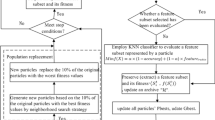Abstract
This study proposes an efficient non-parametric classifier for bankruptcy prediction using an adaptive fuzzy k-nearest neighbor (FKNN) method, where the nearest neighbor k and the fuzzy strength parameter m are adaptively specified by the particle swarm optimization (PSO) approach. In addition to performing the parameter optimization for FKNN, PSO is utilized to choose the most discriminative subset of features for prediction as well. Time varying acceleration coefficients (TVAC) and inertia weight (TVIW) are employed to efficiently control the local and global search ability of PSO. Moreover, both the continuous and binary PSO are implemented in parallel on a multi-core platform. The resultant bankruptcy prediction model, named PTVPSO-FKNN, is compared with three classification methods on a real-world case. The obtained results clearly confirm the superiority of the developed model as compared to the other three methods in terms of Classification accuracy, Type I error, Type II error and AUC (area under the receiver operating characteristic (ROC) curve) criterion. It is also observed that the PTVPSO-FKNN is a powerful feature selection tool which has indentified a subset of best discriminative features. Additionally, the proposed model has gained a great deal of efficiency in terms of CPU time owing to the parallel implementation.
Access this chapter
Tax calculation will be finalised at checkout
Purchases are for personal use only
Preview
Unable to display preview. Download preview PDF.
Similar content being viewed by others
References
Verikas, A., Kalsyte, Z., Bacauskiene, M., Gelzinis, A.: Hybrid and ensemble-based soft computing techniques in bankruptcy prediction: A survey. Soft Computing-A Fusion of Foundations, Methodologies and Applications 14(9), 995–1010 (2010)
Ravi Kumar, P., Ravi, V.: Bankruptcy prediction in banks and firms via statistical and intelligent techniques-a review. European Journal of Operational Research 180(1), 1–28 (2007)
Keller, J.: A Fuzzy k-Nearest Neighbor Algorithm. IEEE Transactions on Systems, Man, and Cybernetics 15(4), 580–585 (1985)
Bian, H., Mazlack, L.: Fuzzy-rough nearest-neighbor classification approach. In: 22nd International Conference of the North American Fuzzy Information Processing Society, NAFIPS 2003, pp. 500–505. IEEE, Los Alamitos (2003)
du Jardin, P.: Predicting bankruptcy using neural networks and other classification methods: The influence of variable selection techniques on model accuracy. Neurocomputing 73(10-12), 2047–2060 (2010)
Chapman, B., Jost, G., Van Der Pas, R.: Using OpenMP: portable shared memory parallel programming. The MIT Press, Cambridge (2008)
Hart, P.: Nearest neighbor pattern classification. IEEE Transactions on Information Theory 13(1), 21–27 (1967)
Kennedy, J., Eberhart, R., et al.: Particle swarm optimization. In: Proceedings of IEEE International Conference on Neural Networks, Perth, Australia, vol. 4, pp. 1942–1948 (1995)
Ratnaweera, A., Halgamuge, S., Watson, H.: Self-organizing hierarchical particle swarm optimizer with time-varying acceleration coefficients. IEEE Transactions on Evolutionary Computation 8(3), 240–255 (2004)
Kennedy, J., Eberhart, R.: A discrete binary version of the particle swarm optimization. In: Proc. Conf. Systems, Man, and Cybernetics, pp. 4104–4108 (1997)
Wieslaw, P.: Application of discrete predicting structures in an early warning expert system for financial distress. PhD thesis. Szczecin Technical University, Szczecin (2004)
Pietruszkiewicz, W.: Dynamical systems and nonlinear Kalman filtering applied in classification. In: 7th IEEE International Conference on Cybernetic Intelligent Systems, CIS 2008, pp. 1–6. IEEE, Los Alamitos (2008)
Salzberg, S.L.: On comparing classifiers: Pitfalls to avoid and a recommended approach. Data Mining and Knowledge Discovery 1(3), 317–328 (1997)
Chang, C., Lin, C.: LIBSVM: a library for support vector machines (2001), http://www.csie.ntu.edu.tw/cjlin/libsvm
Chang, C., Lin, C., Hsu, C.: A practical guide to support vector classification. Department of Computer Science and Information Engineering, National Taiwan University, Taiwan (2003)
Fawcett, T.: An introduction to ROC analysis. Pattern Recognition Letters 27(8), 861–874 (2006)
Author information
Authors and Affiliations
Editor information
Editors and Affiliations
Rights and permissions
Copyright information
© 2011 Springer-Verlag Berlin Heidelberg
About this paper
Cite this paper
Chen, HL., Liu, DY., Yang, B., Liu, J., Wang, G., Wang, SJ. (2011). An Adaptive Fuzzy k-Nearest Neighbor Method Based on Parallel Particle Swarm Optimization for Bankruptcy Prediction. In: Huang, J.Z., Cao, L., Srivastava, J. (eds) Advances in Knowledge Discovery and Data Mining. PAKDD 2011. Lecture Notes in Computer Science(), vol 6634. Springer, Berlin, Heidelberg. https://doi.org/10.1007/978-3-642-20841-6_21
Download citation
DOI: https://doi.org/10.1007/978-3-642-20841-6_21
Publisher Name: Springer, Berlin, Heidelberg
Print ISBN: 978-3-642-20840-9
Online ISBN: 978-3-642-20841-6
eBook Packages: Computer ScienceComputer Science (R0)




